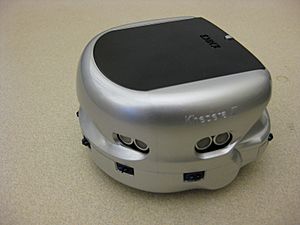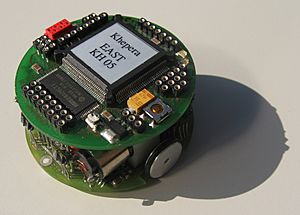Khepera mobile robot facts for kids

The Khepera is a tiny robot that moves around on wheels. It's called a mobile robot. Scientists at a lab in Switzerland created it in the mid-1990s. It was designed by Edo. Franzi, Francesco Mondada, and André Guignard, along with other smart people.
This robot is very small, only about 5.5 centimeters wide! It's also quite fast. For over 10 years, the Khepera robot helped researchers in more than 500 universities all over the world. It was a very important tool for learning about robots.
Contents
Why Khepera Was Important
The Khepera robot was a big deal in the world of science. It was sold to about a thousand research labs! It even appeared on the front cover of Nature, a very famous science magazine, in 2000. This shows how important it was for new discoveries.
Many scientific papers have been written about the Khepera robot. It helped scientists learn a lot about how robots can learn and change over time. This field is called evolutionary robotics.
How Khepera Works
The Khepera robot has different versions, each with improved features. Here are some details about how these small robots are built:
First Version (Original)
- Size: It was about 5.5 centimeters wide and 3 centimeters tall.
- Weight: It weighed only 80 grams, which is less than a small apple!
- Speed: It could move from very slow (0.02 meters per second) to quite fast (1 meter per second).
- Battery Life: It could move for about 45 minutes on its own.
- Brain: It used a Motorola 68331 computer chip running at 16 MHz.
- Memory: It had 256 KB of RAM (short-term memory) and 512 KB of EEPROM (long-term memory).
- Motors: It had two small electric motors that helped it move its wheels precisely.
- Sensors: It had 8 special sensors that could tell if something was close by using infrared light. These sensors could also detect how much light was around.
Second Version (2.0)
This version was an upgrade from the original.
- Brain: It had a faster Motorola 68331 chip, running at 25 MHz.
- Memory: It had more RAM (512 KB) and used Flash memory (512 KB) instead of EEPROM.
- Improvements: It came with better batteries and improved sensors.
Fourth Version (4)
The newest version of the Khepera robot is much more powerful.
- Brain: It has a very fast 800 MHz ARM Cortex-A8 Processor.
- Weight: It weighs 540 grams, which is heavier than the first versions.
- Memory: It has 256 MB of RAM and 512 MB of storage, plus an extra 8 GB for saving data.
- Battery: It uses a strong 7.4V Lithium Polymer battery, which lasts a long time.
Add-ons for Khepera
Scientists can add different tools, called extensions or turrets, to the Khepera robot. These add-ons help the robot do more things. Some examples include:
- Gripper: A small claw to pick up objects.
- Cameras: Small cameras that can be wired or wireless, allowing the robot to "see."
- Radio: Devices to send and receive radio signals, so the robot can communicate with other devices.
- Input/Output (I/O): Ways to connect other electronic parts to the robot.
Simulating Khepera
Because the Khepera robot is so popular, people have created computer programs to simulate it. This means you can test ideas for the robot on a computer before trying them on a real robot.
- Webots is a program that can simulate the Khepera and other robots.
- is another program that simulates the Khepera.
- Khepera III Toolbox is a set of software tools for the Khepera III robot.


